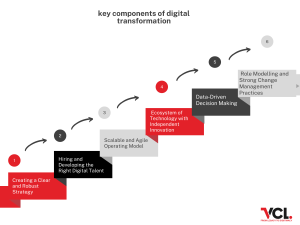Saudi Arabia’s Vision 2030 is a comprehensive plan to reduce the Kingdom’s dependence on oil, diversify its economy, and develop public sectors such as health, education, and infrastructure. One of the pivotal pillars of this vision is technological transformation. This article highlights how key components of digital transformation can support and propel the objectives of Saudi Arabia’s Vision 2030.

- Creating a Clear and Robust Strategy
In alignment with Vision 2030, a robust digital transformation strategy can promote innovation and competitiveness, helping Saudi Arabia move beyond oil reliance. The strategic incorporation of digital technologies can:
- Enhance economic diversity.
- Attract foreign investment.
- Drive growth in non-oil sectors like tourism, entertainment, and renewable energy.
- Hiring and Developing the Right Digital Talent
Vision 2030 emphasizes empowering the youth and fostering a thriving job market. Through:
- Digital skills development.
- Education and training programs.
- Creating opportunities in the tech sector.
Saudi Arabia can build a workforce ready to lead the global digital economy.
- Scalable and Agile Operating Model
Adopting scalable and agile operating models can:
- Enhance efficiency across various sectors.
- Enable quick response to global economic changes.
- Foster innovation in line with Vision 2030’s focus on creating a vibrant society and a thriving economy.
- Ecosystem of Technology with Independent Innovation
Promoting independent innovation through distributed technologies within organisations and adoption of “tribes’ structures” can align with Vision 2030’s goals by:
- Stimulating entrepreneurship.
- Encouraging local businesses and startups.
- Enhancing Saudi Arabia’s position as an innovation hub in the region.
- Data-Driven Decision Making
Data-driven decision-making can enable:
- Better governance and public service delivery, aligned with Vision 2030’s ambition for transparency and efficiency.
- Enhancing the quality of life by improving healthcare and urban planning through informed decisions.
- Facilitating targeted investments in education, infrastructure, and social welfare.
- Role Modelling and Strong Change Management Practices
Effective role modeling and change management practices can:
- Ensure alignment with the cultural transformation envisioned in Vision 2030.
- Foster citizen engagement in the transformation process.
- Enhance public acceptance and commitment to the long-term goals of Vision.
Conclusion
Digital transformation is not just a technological shift; it’s a comprehensive approach that directly aligns with Saudi Arabia’s Vision 2030. By embracing these principles, Saudi Arabia is taking firm strides toward becoming a global investment powerhouse, a hub connecting three continents, and a vibrant society where thriving businesses and a diverse economy coalesce. The alignment between digital transformation and Vision 2030 represents a synergistic partnership where technology fuels growth, and visionary planning builds a sustainable, prosperous future for Saudi Arabia.








